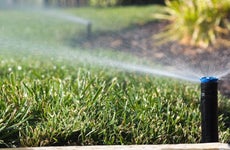Summer home maintenance: a checklist of chores

The Bankrate promise
At Bankrate we strive to help you make smarter financial decisions. While we adhere to strict , this post may contain references to products from our partners. Here's an explanation for .
Spending quality time outdoors during the summer is a well-deserved respite from being trapped in the house all winter, and dodging those showers in the spring. Summer is also a great time to tackle do-it-yourself outdoor projects, like creating a window box, developing your green thumb, and installing a fire pit.
But it’s not all hot fun in the summertime. “An often-overlooked outdoor DIY project is home maintenance — but I’d argue it’s the most important,” explains Michael DiMartino, senior vice president of installations at Power Home Remodeling, a national firm specializing in exteriors. “No matter what renovation projects you take on, prioritizing maintenance of your home’s foundational elements will ensure greater long-term value.”
So, summer is the perfect time to check these six home maintenance projects off your list.
#1: Clean your gutters
Cleaning your gutters is essential to diverting water away from the home and preventing expensive leaks. “No matter where you live — and especially in regions prone to snow and other precipitation — your gutters have likely developed a collection of materials like sticks, leaves, even birds’ nests throughout the year,” DiMartino explains. And if this debris isn’t cleaned out, it can lead to blockages.
“If water can’t escape and has nowhere to empty, it will start to cause moisture erosion on your siding and eventually infiltrate your home’s foundation.” (In fact, even if you have gutter guards installed, he warns you still need to check periodically to see what’s happening up there.)
You could tackle this chore earlier in the year, but since spring storms often could bring more debris, it’s advisable to follow up in the summer, especially as malfunctioning gutter problems can spread to the rest of the house. “Overflowing gutters are the number one cause of issues with cracked foundations due to basement water problems and rotting fascia boards that can cause your gutters to pull away from the house,” says Ken Fisk, director of technical services of Window Genie. “Free-standing water in the gutters can also cause an influx in pests, such as mosquitoes and termites.”
“The most preferred way to flush out debris in your gutter is by using a water hose with a high-pressure attachment after you have cleaned the gutters by hand,” Fisk says. You can also vacuum out gutters using attachments that often come with wet/dry vacuums (and he says they can be rented at a local hardware store).
Make sure you use a solid, sturdy ladder. If your gutters are too high, or you don’t feel comfortable climbing, both DiMartino and Fisk recommend calling in a professional.
#2: Clean your windows
Most people don’t realize how dirty their windows are until they clean them. But to get the right effect, you need the right materials. “Use a homemade solution of dish soap and water, instead of harsh glass cleaners that include ammonia or petroleum, because they can damage your windows,” DiMartino says. He also recommends wiping with newspaper. “It’s the best material to use on glass, because it doesn’t leave behind residue like paper towels can.”
Another caution: Don’t use a pressure washer to clean your windows. “While it may seem like the safest practice because it allows you to reach higher windows from the ground, the impact of that water pressure can break your glass or window sealants and eventually cause unwanted moisture in your home’s interior insulation,” DiMartino warns. If you have double pane windows, water can seep inside of the window sealant — but has no way to get out. “This causes a foggy residue which is a prime distinction of seal failure, and it’s not something a DIYer can fix,” he explains.
And when cleaning your windows, don’t forget to clean your window screens. “Rain might help keep your windows clear but if your screens are not cleaned, you still aren’t going to have a clear view,” says Fisk. To clean the window screens, take them off the windows. “You can put a tarp down to lay the screens on or prop them up on a fence or tree, then gently spray the screens with the water hose, making sure to tackle any stuck-on residue,” he says. Allow the screens to dry naturally in the sun and wind before securing them back to the window.
No matter what renovation projects you take on, prioritizing maintenance of your home’s foundational elements will ensure greater long-term value.
— Michael DiMartinoSenior Vice President of installations at Power Home Remodeling
#3: Refresh or replace your shutters
If you have shutters, DiMartino recommends cleaning them after dealing with your windows. “The best way to care for shutters is to remove them from your windows completely and clean them separately on the ground,” he says. “You can use your regular garden hose to wash them and a cloth and cleaning solution to wipe them down.” Depending on how they look, DiMartino says you can give your house a little facelift by painting the shutters.
But paint can’t solve all problems. If the shudders themselves look pitted or rotted, Kevin Busch, VP of operations for Mr. Handyman, recommends replacing them with a new set of shutters. “Start by measuring your existing shutters, both width, and height, then purchase replacements through a local home center or lumber yard.” He recommends using a sturdy ladder with enough height to reach the work area.
“After ensuring that you can work safely from the ladder, remove the existing shutters using cordless or handheld tools.” If you’re lucky, he says the mounting holes for the new shutters will line up with the old ones. “If not, follow the manufacturer’s instructions for attaching the new shutters to your home.”
#4: Inspect your roof
A new roof is an expensive investment and that’s why you should stay on top of any potential problems. While roof repairs are best handled by professionals, DiMartino says, there’s no reason why you can’t at least survey the situation. “The spring/summer season is a great time to prioritize inspections and set yourself up for a successful project later in the year.”
First, do a walkaround on the ground or from upper-story windows; then, if you can easily and safely access your roof, he recommends taking a look around to see if any damage is visible. “You should be on the lookout for things like mold or leaks, which can seep their way down into the foundational structure of your home, as well as missing or damaged shingles, which are common after winter storms.” DiMartino says it’s essential to replace those shingles to prevent additional damage to lower layers on your roof.
If you do notice any damage, he recommends getting ahead of the busy fall season by researching, vetting and scheduling time with professional contractors. “And any roofing professional worth their while will inspect your attic along with the exterior of your roof,” DiMartino adds. Why would your attic need to be inspected? It’s often another clue to roofing problems, via active leaks, cracked rafters or signs of darkened spots on your plywood or sheathing.
#5: Stain and seal your deck
Early summer is also a good time of the year to prep your deck (beyond the hosing-off you gave it in the early days of spring). “Staining and sealing your deck is one of my top recommended projects as many long summer and fall days will be spent here,“ says David Steckel, home expert at Thumbtack. Even “if it has previously been stained, you’re going to have to redo it every few years, and sealing your deck is always a good idea to maintain the condition of the wood.”
“Our data shows that deck staining and sealing has increased by 755 percent [since March 2022], so it’s clearly a priority for a lot of folks too.”
These steps do more than keep the wood looking good. Steckel says it’s one of the most important things you can do to preserve your deck’s structural integrity. “This maintenance project protects your deck from sun damage, and keeps moisture out — preventing common problems like mold, mildew, rot, and wood expansion.”
And while this can indeed be a DIY project, Steckel recommends calling in the pros. “Your deck will experience a lot of wear and tear during the summer, so you want to ensure it’s done right.”
#6: Check your weatherstripping
“Make sure to replace worn-out weatherstripping on doors and windows to ensure wind and water stay outside of your home and do not enter through any cracks or holes,” advises Busch.
You may think of weatherstripping as a winter project. But when winter’s bitter wind is blowing, who wants to be outside struggling to seal doors and windows? Summer is the perfect (or at least more pleasant) time to get gap-plugging out of the way.
Another reason to tackle this project now: Drafts and air leaks affect air conditioning too. According to Energy.gov, you can save more than 20% on your heating and cooling bills by dealing with defective weatherstripping in summer.
While you’re at it, don’t forget to check the fixtures. “Make sure window and door locks operate properly to create a weathertight seal,” Busch says.
Related Articles




Spring cleaning checklist: home maintenance projects to tackle